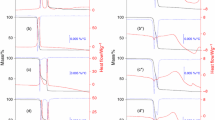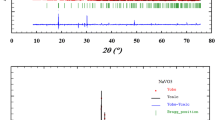Abstract
The transformation of vivianite and the direct synthesis starting from pure chemicals lead to the formation of lipscombite {Fe 2+x Fe 3+3−x [(OH)3−x/(PO4)2]} with varying Fe2+/Fe3+ molar ratios. The influence of this ratio on the Mössbauer spectra, solubility, electrokinetic potential and infrared spectra has been studied. By means of Mössbauer spectroscopy, the distribution of the Fe2+ and Fe3+ ions between the octahedral sites I and II has been investigated.
The unit cell dimensions have been determined from Guinier-Hägg X-ray diffraction patterns. The crystal system is tetragonal for synthetic lipscombite with a=5.3020±0.0005 Å and c=12.8800±0.0005 Å.
Lipscombite has been found to show a negative and time-dependent zeta-potential which, moreover, is influenced by the pH of the suspension and the Fe2+/Fe3+ molar ratio. An explanation of the time-dependence of the zeta-potential on variations of solubility is proposed.
Infrared absorption spectrum only is characterized by two absorption bands: v OH(3,500 cm−1) and v P−O(1,100-960 cm−1). The density at 25° C is determined in toluene as 3.36±0.01 g·cm−3.
Similar content being viewed by others
References
Bulach AG (1964) Berechnung von Mineralformeln. VEB Deutscher Verlag für Grundstoffindustrie, Leipzig
Cohen M (1935) Precision lattice constants from X-ray powder photographs. Rev Sci Instrum 6:68–74
Cohen M (1936) Rev Sci Instrum 7:155
Dauwe C, Dorikens M, Dorikens-Van Praet L (1974) Analysis of double decay spectra by the SIMPLEX stepping method. Appl Phys 5:45–47
Dormann JL, Poullen JF (1980) Etude par spectroscopie Mössbauer de vivianites oxydées naturelles. Bull Mineral 103:633–639
Farmer VC (1974) The infrared spectra of minerals. Mineralogical Society, Monograph 4, p 402
Farzaneh B, Troll G (1977) Quantitative Hydroxyl- und H2O-Bestimmungsmethode für Minerale, Gesteine und andere Festkörper. Fresenius Z Anal Chem 287:43–45
Faye GH, Manning PG, Nickel EH (1968) The polarized optical absorption spectra of tourmaline, cordierite, chloritoid and vivianite: ferrous-ferric electronic interaction as a source of pleochroism. Am Mineral 53:1174–1201
Gheith MA (1953) Lipscombite: a new synthetic “iron lazulite”. Am Mineral 38:612–628
Jeffery PG (1975) Chemical methods of rock analysis. Pergamon Press, Oxford
Katz L, Lipscomb WN (1951) The crystal structure of iron lazulite, a synthetic mineral related to lazulite. Acta Crystallogr 4:345–348
Lindberg ML, Pecora WT (1955) Tavorite and barbosalite, two new phosphate minerals from Minas Geraes, Brazil. Am Mineral 40:952–966
Lindberg ML, Pecora WT (1958) Phosphate minerals from the Sapucaia pegmatite mine, Minas Geraes, Brazil. Bol Soc Bras Geol 7:5–14
Lindberg ML (1962) Managanoan lipscombite from the Sapucaia pegmatite mine, Minas Gerais, Brazil. First occurence of lipscombite in nature. Am Mineral 47:353–359
Mattievich E, Danon J (1977) Hydrothermal synthesis and Mössbauer studies of ferrous phosphates of the homologous series Fe 2+3 (PO4)2 (H2O)n. J Inorg Nucl Chem 39:569–580
Moenke H (1962) Mineralspektren I. Akademie-Verlag, Berlin
Moenke H (1966) Mineralspektren II. Akademie-Verlag, Berlin
Moore PB (1971) The Fe 2+3 (H2O)n(PO4)2 homologous series: crystalchemical relationships and oxidized equivalents. Am Mineral 56:1–17
Poullen JF (1979) Nouvelles données sur la vivianite et la métavivianite. CR Acad Sci Paris Ser D: 285:51–52
Visser J (1969) Zone indexing. J Appl Crystallogr 2:89
Vochten RF, Grave E De, Stoops G (1979) Petrographic, chemical and Mössbauer study of some oxidized vivianite nodules from Retie (Province of Antwerp, Belgium). N Jahrb Mineral Abh 137:208–222
Vochten RF, Huybrechts W, Remaut G, Deliens, M (1979) Formation of meta-torbernite starting from curite; crystallographic data and electrokinetic properties. Phys Chem Minerals 4:281–290
Vochten RF, Deliens M (1980) Transformation of curite into metaautunite. Paragenesis and electrokinetic properties. Phys Chem Minerals 6:129–143
Author information
Authors and Affiliations
Rights and permissions
About this article
Cite this article
Vochten, R., De Grave, E. Crystallographic, Mössbauer and electrokinetic study of synthetic lipscombite. Phys Chem Minerals 7, 197–203 (1981). https://doi.org/10.1007/BF00311889
Received:
Issue Date:
DOI: https://doi.org/10.1007/BF00311889




